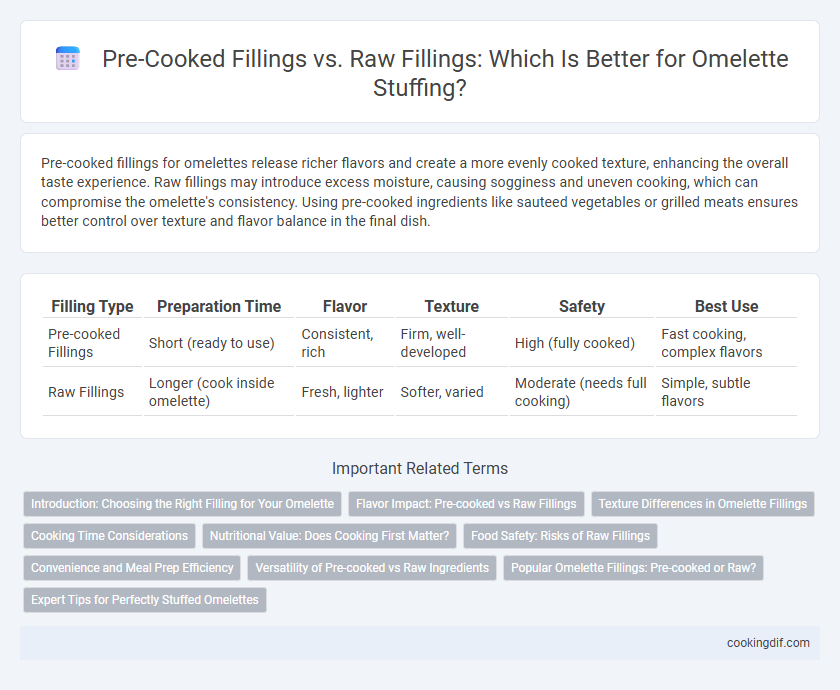Pre-cooked fillings for omelettes release richer flavors and create a more evenly cooked texture, enhancing the overall taste experience. Raw fillings may introduce excess moisture, causing sogginess and uneven cooking, which can compromise the omelette's consistency. Using pre-cooked ingredients like sauteed vegetables or grilled meats ensures better control over texture and flavor balance in the final dish.
Table of Comparison
| Filling Type | Preparation Time | Flavor | Texture | Safety | Best Use |
|---|---|---|---|---|---|
| Pre-cooked Fillings | Short (ready to use) | Consistent, rich | Firm, well-developed | High (fully cooked) | Fast cooking, complex flavors |
| Raw Fillings | Longer (cook inside omelette) | Fresh, lighter | Softer, varied | Moderate (needs full cooking) | Simple, subtle flavors |
Introduction: Choosing the Right Filling for Your Omelette
Selecting the right filling for your omelette depends on whether you prefer pre-cooked or raw ingredients, as each impacts texture and flavor differently. Pre-cooked fillings like sauteed mushrooms, grilled peppers, or cooked bacon ensure even cooking and enhanced taste, while raw fillings such as fresh tomatoes or spinach retain a crisp, vibrant freshness. Understanding the cooking times and moisture levels of your chosen fillings helps create a perfectly balanced and delicious omelette.
Flavor Impact: Pre-cooked vs Raw Fillings
Pre-cooked fillings in omelettes deliver a deeper, more developed flavor due to caramelization and moisture reduction during cooking, enhancing overall taste complexity. Raw fillings often release excess water when heated, diluting the omelette and weakening flavor intensity. Selecting pre-cooked ingredients like sauteed mushrooms, caramelized onions, or seared meats optimizes rich, concentrated flavors compared to the milder, less integrated taste of raw fillings.
Texture Differences in Omelette Fillings
Pre-cooked fillings in omelettes provide a tender and evenly cooked texture, preventing excess moisture that can make the omelette soggy. Raw fillings, such as fresh vegetables or uncooked meats, often release water during cooking, resulting in a less cohesive texture and potential uneven cooking. Choosing pre-cooked ingredients ensures a balanced consistency and a more pleasant mouthfeel in the final omelette.
Cooking Time Considerations
Pre-cooked fillings reduce overall omelette cooking time by requiring only reheating, preventing overcooking of eggs and ensuring even temperature distribution. Raw fillings often need longer cooking within the omelette, risking uneven textures and wetter results due to moisture release. Careful selection between pre-cooked and raw fillings directly impacts the final texture, flavor integration, and cooking efficiency of the omelette.
Nutritional Value: Does Cooking First Matter?
Pre-cooked fillings for omelettes retain more nutrients by reducing cooking time and heat exposure during omelette preparation, preserving vitamins sensitive to high temperatures like vitamin C and B-complex. Raw fillings often contain higher water content and enzymes but risk nutrient loss or foodborne pathogens without proper cooking. Choosing pre-cooked ingredients such as sauteed vegetables or cooked meats enhances bioavailability and safety, ultimately maintaining better nutritional value in the finished omelette.
Food Safety: Risks of Raw Fillings
Using pre-cooked fillings in omelettes significantly reduces the risk of foodborne illnesses caused by bacteria such as Salmonella and E. coli commonly found in raw ingredients like raw meats or shellfish. Raw fillings require thorough cooking to an internal temperature of at least 165degF (74degC) to ensure safety, which can be challenging to achieve evenly within the omelette without overcooking the eggs. Pre-cooked fillings, including sauteed vegetables or fully cooked meats, provide a safer, more convenient option while maintaining flavor and texture integrity.
Convenience and Meal Prep Efficiency
Pre-cooked fillings for omelettes enhance convenience by reducing overall cooking time and ensuring even heat distribution, making meal prep efficient and consistent. Raw fillings require longer cooking, increasing preparation time and the risk of unevenly cooked ingredients, which can disrupt meal planning rhythms. Utilizing pre-cooked ingredients streamlines the assembly process and supports faster service in busy kitchens or quick family meals.
Versatility of Pre-cooked vs Raw Ingredients
Pre-cooked fillings offer greater versatility for omelette stuffing by allowing precise flavor control and consistent texture, reducing cooking time during assembly. Raw fillings provide freshness and natural moisture but require careful cooking to avoid sogginess or undercooked ingredients, which can affect the overall omelette quality. Selecting pre-cooked ingredients like sauteed mushrooms, grilled vegetables, or cooked meats simplifies preparation and enhances adaptability across diverse recipes.
Popular Omelette Fillings: Pre-cooked or Raw?
Popular omelette fillings often vary between pre-cooked ingredients such as sauteed mushrooms, cooked ham, or caramelized onions, and raw options like fresh tomatoes, spinach, or diced bell peppers. Pre-cooked fillings enhance flavor development and ensure even cooking, while raw fillings offer a fresher texture and vibrant taste within the omelette. Balancing pre-cooked and raw fillings can create optimal texture and flavor profiles in omelette stuffing.
Expert Tips for Perfectly Stuffed Omelettes
Pre-cooked fillings for omelette stuffing, such as sauteed mushrooms, grilled peppers, or cooked bacon, release less moisture, preserving the omelette's texture and preventing sogginess. Raw fillings like fresh tomatoes or onions can introduce excess water, requiring careful reduction or quick sauteing before incorporation to maintain the desired consistency. Expert chefs recommend balancing moisture content and pre-cooking density to achieve perfectly stuffed omelettes with evenly distributed flavors and an ideal fluffy interior.
Pre-cooked fillings vs raw fillings for omelette stuffing Infographic

 cookingdif.com
cookingdif.com